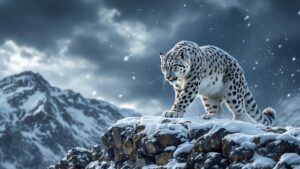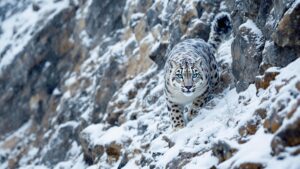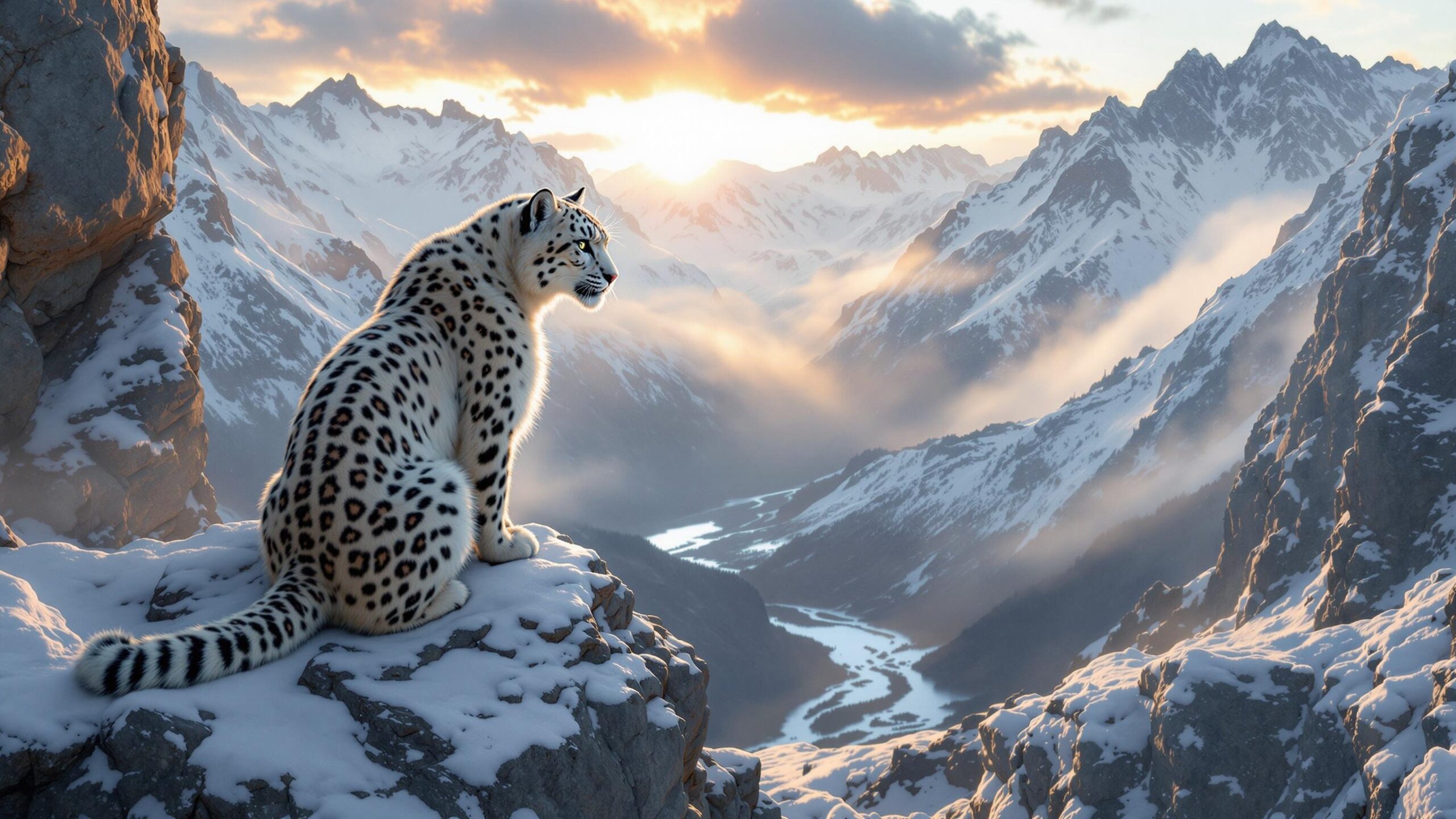Snow Leopards: The Ghosts of the Mountains and Guardians of the High Himalayas
High above the tree line, where the earth brushes the sky and snow lingers year-round, a solitary shape glides silently across a craggy ledge. Clad in a cloak of misty-gray fur and dappled with black rosettes, the snow leopard is both a symbol of nature’s raw elegance and a survivor in one of the harshest habitats on Earth. Elusive, rarely seen, and revered across cultures, the snow leopard (Panthera uncia) is often called the “ghost of the mountains” for good reason. To witness one in the wild is akin to spotting a dream—a fleeting, sacred glimpse into a world few will ever know.
The snow leopard’s story is not just one of beauty or mystery. It is a tale of adaptation, ecological balance, and the mounting challenges of survival in a rapidly changing world. These apex predators are key to the health of their high-altitude ecosystems, quietly orchestrating a delicate equilibrium among prey species, vegetation, and terrain. They are also one of the most endangered big cats, threatened by habitat fragmentation, climate change, poaching, and human-wildlife conflict.

Central Asian Snow Leopard
The Central Asian Snow Leopard: Ghost of the Mountains High in the rugged, windswept peaks of Central Asia, where the air thins and silence reigns, a rare and elusive predator prowls. Revered in ancient myths and whispered about in local folklore, the Central Asian Snow Leopard (Panthera uncia) moves with a quiet elegance and an almost supernatural stealth. It’s no surprise that this big cat has earned the evocative title

Himalayan Snow Leopard
Himalayan Snow Leopard: The Ghost of the Mountains High above the clouds in the towering peaks of the Himalayas roams a creature so elusive, so ghostlike, that for centuries it seemed to exist only in myth and whisper. The Himalayan Snow Leopard (Panthera uncia), often referred to as the “Ghost of the Mountains,” is one of the world’s most breathtaking and mysterious big cats. Known for its extraordinary camouflage, silent
The Marvel of Mountain Design: Biological and Physical Adaptations of the Snow Leopard
The snow leopard is a masterpiece of evolutionary engineering, finely tuned to thrive in extreme mountainous environments ranging from 9,800 to over 18,000 feet. Found across the rugged ranges of Central and South Asia, including the Himalayas, Tian Shan, Altai, and Pamir mountains, it occupies a domain few creatures can endure. Cold, rocky, and isolated, this realm demands a special set of tools—and the snow leopard delivers.
Its dense, woolly fur insulates against temperatures that plunge below -30°F, while oversized nasal cavities warm the air before it reaches the lungs. Snow leopards possess a short, stocky frame that conserves body heat, and their powerful hind legs allow them to leap up to 50 feet in a single bound—ideal for navigating steep cliffs and deep ravines. Their wide, fur-covered paws act like snowshoes, distributing weight to prevent sinking into the snow. The snow leopard’s long, thick tail provides balance during agile maneuvers and doubles as a cozy scarf when curled up against the wind.
But perhaps its most striking feature is its camouflage. The snow leopard’s smoky-gray coat with charcoal rosettes and spots blends seamlessly with the rocks and snow of its surroundings, making it nearly invisible to prey and predator alike. This extraordinary stealth is one reason why it remains so elusive, even in areas where its presence is well-documented.
The Himalayas: Stronghold of the Snow Leopard’s Spirit
The Himalayas, Earth’s tallest mountain range, form the spiritual and ecological core of snow leopard territory. Stretching across Nepal, Bhutan, India, and Tibet, this region offers both the altitude and isolation the species favors. Here, snow leopards prowl through glacial valleys, rugged ridgelines, and alpine meadows, often shadowing herds of bharal (blue sheep) and Himalayan tahr.
In Nepal’s Annapurna and Manaslu regions, snow leopards are increasingly becoming icons of conservation-led tourism. Trekking lodges and community-led wildlife programs work together to monitor populations and minimize human conflict. These efforts include building predator-proof corrals to protect livestock and offering compensation programs for losses, ensuring that the presence of the snow leopard is viewed as a benefit, not a burden.
The Himalayas also serve as cultural strongholds. In Buddhist philosophy, the snow leopard is seen as a guardian of sacred mountains and a symbol of balance. This spiritual reverence often bolsters conservation, as many Himalayan communities regard harming the animal as a violation of spiritual harmony.
The Tibetan Plateau and Gobi Steppe: Remote Kingdoms of Ice and Rock
Beyond the Himalayas lies the Tibetan Plateau—the highest and largest in the world. Here, the air is thin, the landscape harsh, and human habitation sparse. But snow leopards find a fitting home in this land of sprawling glaciers, dry steppe grasslands, and high-altitude deserts. The plateau’s vast open expanses demand greater stealth and endurance, but also offer an abundance of wild prey, such as argali sheep and pika.
In Mongolia’s portion of the Gobi, snow leopards share space with herders who graze yak, sheep, and goats. Conservation programs in this region emphasize coexistence through education, livestock protection, and community partnerships. Snow Leopard Trust, one of the most prominent organizations dedicated to the species, has pioneered initiatives that include handicraft cooperatives for herder families, enabling economic support without wildlife exploitation.
Research in these regions is shedding light on the incredible distances these cats travel—sometimes covering over 600 square miles in their search for food and mates. GPS collaring has revealed surprising cross-border movements, making international collaboration essential for their protection.
Central Asia’s High Ranges: Kazakhstan, Kyrgyzstan, and the Tien Shan Mountains
The rugged spines of the Tien Shan, Pamirs, and Alay mountains stretch across Central Asia, forming another vital stronghold for the snow leopard. Kazakhstan and Kyrgyzstan are home to some of the most rugged and biologically rich terrain in the region, offering habitat to ibex, markhor, and marmots—core components of the snow leopard’s diet. Here, snow leopards are often caught on camera traps in remote valleys, moving silently through snowfields and boulder fields. In Kyrgyzstan, conservation has taken a creative turn, with wildlife rangers dubbed “Snow Leopard Guardians” who patrol critical habitats and engage local schools in environmental education. These Central Asian ranges also harbor unique conservation challenges. Traditional poaching, outdated mining operations, and new hydropower projects threaten to fragment habitats and disrupt prey populations. However, strong regional pride in the snow leopard, combined with increasing tourism and international funding, is laying the groundwork for long-term solutions.
The Western Frontiers: Pakistan, Afghanistan, and the Hindu Kush
In the westernmost reaches of its range, the snow leopard roams the sharp cliffs and deep ravines of the Hindu Kush, Karakoram, and Hindu Raj ranges. Pakistan’s Gilgit-Baltistan and Khyber Pakhtunkhwa provinces offer some of the most dramatic scenery on Earth—and a challenging environment for both humans and wildlife. Here, snow leopards face more than just natural obstacles. Political instability, limited infrastructure, and poverty complicate conservation efforts. Yet hope persists. In recent years, local NGOs and global partners have launched successful snow leopard monitoring and livestock insurance schemes, reducing retaliatory killings and increasing community support.
In Afghanistan, war and conflict have made wildlife research nearly impossible in many regions. Yet scattered camera trap photos and field reports suggest that snow leopards still endure in the Wakhan Corridor and Badakhshan Province. Their survival here is a symbol of both nature’s resilience and the potential for peace-building through shared environmental goals.
Behavior and Hunting: Stealth Over Strength
Snow leopards are solitary and highly elusive, making direct observation rare. They are most active at dawn and dusk, using their keen vision and acute hearing to detect movement across vast distances. Unlike lions or tigers that overpower prey with brute force, snow leopards depend on stealth, camouflage, and the element of surprise. They stalk prey quietly across rocky terrain, then explode into a sprint during the final moments, often launching themselves in powerful leaps from cover.
Their diet consists mainly of wild ungulates—bharal, ibex, argali, tahr, and markhor—but they are opportunistic and may take smaller mammals, birds, and even domestic livestock when wild prey is scarce. Snow leopards typically make a kill every 8–10 days, and will remain near their prey for several days while feeding and resting in rocky alcoves.
They do not roar like other big cats. Instead, they communicate using mews, hisses, growls, and low-frequency “chuffing” sounds. Their scent-marking and scrapes serve as territorial signals, and though highly solitary, overlapping ranges and camera trap footage suggest snow leopards are more socially complex than previously thought.
Reproduction, Cubs, and Early Survival
Snow leopards mate between January and March, with cubs born in late spring to early summer—timed to coincide with warmer weather and a relative abundance of prey. After a gestation of about 90–100 days, the female gives birth in a sheltered den, often among boulders or caves, where she cares for 1–3 cubs. The cubs are born blind and helpless, their eyes opening around nine days after birth. For the first two months, they remain hidden while nursing and growing strong enough to explore. By the time they emerge, they are already developing the stealth and agility required to survive in such a demanding landscape. The mother teaches her cubs how to hunt, climb, and stalk, leading them to kills and gradually encouraging independence. Around 18–22 months of age, the cubs disperse to find their own territories. However, survival rates are low—only about half of snow leopard cubs reach adulthood. Climate extremes, accidents, and lack of prey contribute to early mortality, underscoring the need for protective habitat management.
Snow Leopards in Culture, Legend, and Symbolism
Snow leopards are more than just ecological actors—they are cultural icons woven into the myths, art, and identities of highland communities. In Tibetan Buddhism, the snow leopard is considered a protector of sacred mountains and an embodiment of fierce wisdom . In Central Asian folklore, it is portrayed as a guardian spirit, swift and untouchable. Nationally, the snow leopard is the state animal of Pakistan, the national heritage animal of Afghanistan, and a conservation symbol in countries like Kyrgyzstan and Mongolia. The elusive cat has become a unifying figure in transboundary conservation agreements, such as the Global Snow Leopard and Ecosystem Protection Program (GSLEP), signed by all 12 range countries in 2013. This symbolic power has real-world conservation value. Communities that identify with the snow leopard are more likely to engage in its protection, and tourism centered around snow leopard sightings provides economic incentives for preservation.
Threats to Survival and the Push for Conservation
Despite their legendary adaptability, snow leopards face growing threats. Habitat fragmentation from mining, roads, and development isolates populations and impedes movement. Declining prey populations—often due to overgrazing by livestock—force snow leopards into conflict with herders. Poaching for their fur, bones, and organs continues despite international bans. And climate change is shrinking the alpine zones they depend on, pushing tree lines higher and disrupting prey dynamics.
Conservationists are tackling these issues through a variety of approaches: high-tech tracking and monitoring, community education, compensation schemes, and protected area expansion. Organizations like the Snow Leopard Trust, WWF, and Panthera are leading research and grassroots programs that prioritize coexistence and habitat connectivity.
Perhaps most promising is the shift toward community-led conservation. In many parts of the snow leopard’s range, herders and villagers are becoming stewards of the cat’s future—reporting sightings, reducing retaliatory killings, and participating in eco-tourism ventures that link prosperity with preservation.
Echoes in the Peaks, and the Promise of Protection
The snow leopard is more than an icon of the high mountains. It is the silent thread that holds together some of the most fragile ecosystems on the planet. Its presence signals balance, its absence warns of unraveling. In every pawprint etched into a snowy ledge, there is a story of survival, silence, and the sublime interconnection of all life. As we stand at a crossroads between ecological collapse and renewal, the snow leopard offers a path forward—one where reverence, science, and collaboration blend into something greater. Protecting this elusive cat isn’t just about saving a species; it’s about honoring the wild beauty that still exists in our world and choosing to preserve it for generations to come. Let this be your invitation to explore deeper. Discover the snow leopard’s haunts in the Himalayas, the myths that surround it in Mongolia, and the science that reveals its hidden life. Follow the tracks into the clouds. The ghost of the mountains is waiting, watching, and hoping we’re ready to follow.

